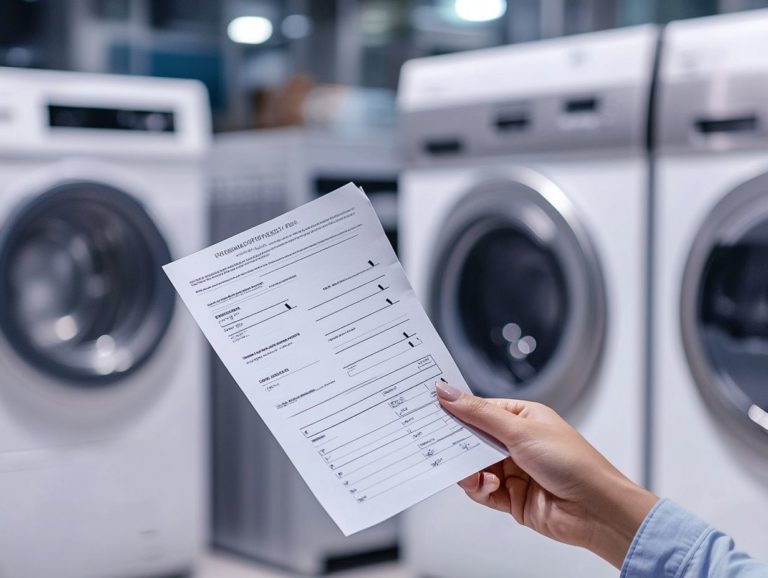Understanding Warranty Exclusions and Limitations
Warranties are important promises when you buy products, offering you protection against defects.
Understanding warranties—like their types, coverage options, and common exclusions—can be confusing.
This guide simplifies the basics of warranties, clarifying what is typically covered and what isn’t. It also outlines the claims process and gives practical tips to help you avoid warranty issues.
Whether you’re a seasoned shopper or new to warranties, this guide will help you make informed decisions.
Contents
- Key Takeaways:
- The Basics of Warranties
- Exclusions in Warranties
- Understanding Warranty Coverage
- How to Handle Warranty Claims
- Tips for Avoiding Warranty Issues
- Frequently Asked Questions
- What are warranty exclusions and limitations?
- What types of things may be excluded from a warranty?
- Why do warranties have limitations?
- How can I find out about the warranty exclusions and limitations for my product?
- Are there any ways to void a warranty?
- What should I do if I encounter an issue that is not covered by the warranty?
Key Takeaways:
- Warranties are agreements that protect products or services, but they often come with limitations and exclusions.
- Common exclusions include wear and tear, improper use, and lack of maintenance. It’s important to know what is covered and what is not.
- To handle warranty claims successfully, document the issue, follow the right steps, and communicate effectively with the warranty provider.
The Basics of Warranties
Warranties are promises from manufacturers to you, the consumer, assuring that their products meet specific standards and are free from defects. These promises are governed by the Magnuson-Moss Warranty Act, which sets standards for warranties in the U.S.
This legal framework is designed to protect you, offering different types of warranties, including implied warranties—automatic protections that come with your purchase—and express warranties, which are clearly stated by the manufacturer.
What is a Warranty?
A warranty is a written promise from a manufacturer or seller to you, ensuring the quality and performance of a product for a specific time.
This assurance is crucial for you as a buyer, showcasing the seller’s confidence in their product and providing a legal safety net.
By outlining specific conditions—like coverage for defects and maintenance requirements—a warranty explains your rights if the product fails to meet your expectations.
If there are issues, this contract allows you to seek repairs, replacements, or even refunds, reinforcing your right to a functioning product. Understanding warranty terms can greatly influence your purchasing decisions and enhance your sense of security as a consumer.
Types of Warranties
Warranties come in different forms, so it’s essential to know them. You have express warranties, which the manufacturer clearly outlines, and implied warranties, which are automatically included to ensure reliability.
Understanding these distinctions is vital for making informed purchasing decisions. Express warranties detail the terms regarding coverage and duration, often specifying particular parts or services included.
Limited warranties restrict coverage to specific repairs or replacements, while standard warranties usually offer broader terms covering more defects or failures.
Each type varies in coverage extent and the conditions for seeking recourse, shaping your expectations and guiding your choices.
Exclusions in Warranties
Understanding warranty exclusions is crucial for you as a consumer. These stipulations define situations where the warranty is void, often pointing out conditions like unauthorized repairs or damages from natural disasters.
Being aware of these exclusions helps you make informed decisions and protects your investment.
Common Exclusions and Limitations
Common exclusions in warranties often specify conditions where repairs won’t be covered, like failing to provide proper documentation or not following maintenance guidelines.
These restrictions highlight the importance of following all warranty conditions. It’s easy to overlook the need to keep receipts or service records, yet these are crucial for validating your claims. For example, neglecting routine maintenance could lead to denial of coverage.
Understanding these nuances increases the likelihood that your claims will be honored.
Understanding Warranty Coverage
Warranty coverage defines your protection against product defects, including repairs, parts, and labor for a specified period as outlined in your warranty documentation.
What is Covered and What is Not?
To know what your warranty covers, review the specific terms in the warranty documentation. Usually, defects in materials or workmanship are included, while exclusions might apply to damages from misuse or neglect.
Many warranties cover reasonable wear and tear, but damages from accidents or improper maintenance may not be covered. If a product fails due to a manufacturing defect, that’s likely covered; however, if it fails due to neglect or unauthorized modifications, those claims may be denied.
If you value your purchases, take the time to review your warranty details thoroughly. This ensures you understand what is included and the conditions that could void your coverage.
How to Handle Warranty Claims
Navigating the warranty claims process involves understanding the essential steps, including providing proof of purchase and following the responsibilities outlined in the warranty terms.
Knowing these elements empowers you to approach your claim with confidence and clarity.
Steps to Take for a Successful Claim
To boost your chances of a successful warranty claim, meticulously document your case, gather necessary paperwork, and closely follow the manufacturer’s claims process.
Start by collecting all relevant receipts, manuals, and any correspondence with the manufacturer. Understand your legal rights, as warranty laws vary by location, offering critical protections.
Maintaining clear communication with the manufacturer is also vital; don’t hesitate to ask for clarification on the claims process. Keeping a written record of all interactions strengthens your case, ensuring every step is documented.
Tips for Avoiding Warranty Issues
To avoid warranty complications, follow best practices such as performing regular maintenance, avoiding unauthorized modifications, and keeping detailed records of inspections and repairs as required by the warranty.
This proactive approach will help ensure your warranty remains intact and your investment is protected.
Preventive Measures and Best Practices
Regular maintenance checks and following warranty responsibilities help prevent disputes and maintain coverage.
By inspecting your products for signs of wear or potential issues regularly, you can catch small problems before they escalate, ultimately protecting your investments. Keeping accurate records of maintenance work—like receipts and service logs—shows your diligence and strengthens your claims.
Familiarize yourself with the fine print of your warranties, as this knowledge helps you understand what is covered and follow specific requirements. By adopting these best practices, you maintain the functionality of your products and cultivate a sense of responsibility to prevent future inconveniences.
Frequently Asked Questions
What are warranty exclusions and limitations?
Warranty exclusions and limitations specify situations where the warranty won’t cover repairs or replacements. Understanding these is crucial. It helps you avoid voiding your warranty or facing unexpected costs.
What types of things may be excluded from a warranty?
Warranties often exclude damage from accidents, misuse, neglect, or unauthorized repairs. Normal wear and tear, cosmetic damage, and damage from non-manufacturer-approved accessories may also be excluded.
Why do warranties have limitations?
Warranties have limitations to protect the manufacturer from liability. You can usually find these limitations in the warranty documentation, which can vary by product and manufacturer.
How can I find out about the warranty exclusions and limitations for my product?
Look for information about warranty exclusions and limitations in the warranty documents that came with your product. Read these documents carefully. If you have questions, ask the manufacturer or retailer.
Are there any ways to void a warranty?
Yes, several actions can void a warranty. Not following the manufacturer’s instructions, using the product incorrectly, or making unauthorized repairs can void your warranty.
What should I do if I encounter an issue that is not covered by the warranty?
Don’t worry! You might still have options. Contact the manufacturer or retailer to see if they offer additional coverage or if there are repair services available for a fee. Consider buying an extended warranty for added protection in the future.
Lastly, review your warranty details regularly or contact the manufacturer for clarification to ensure you are fully informed.

.jpg_00.jpeg)
.jpg_01.jpeg)
.jpg_10.jpeg)
.jpg_11.jpeg)





